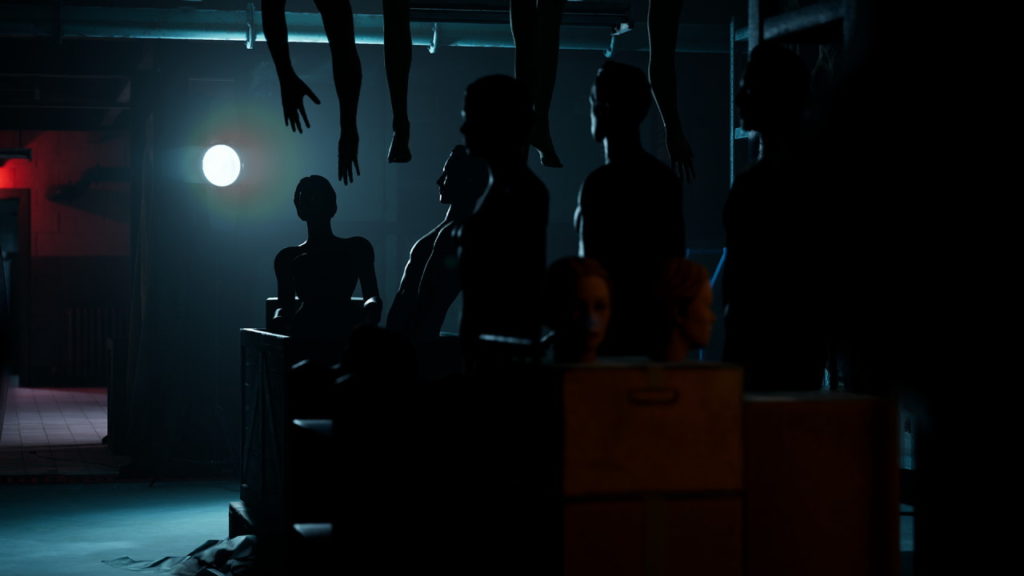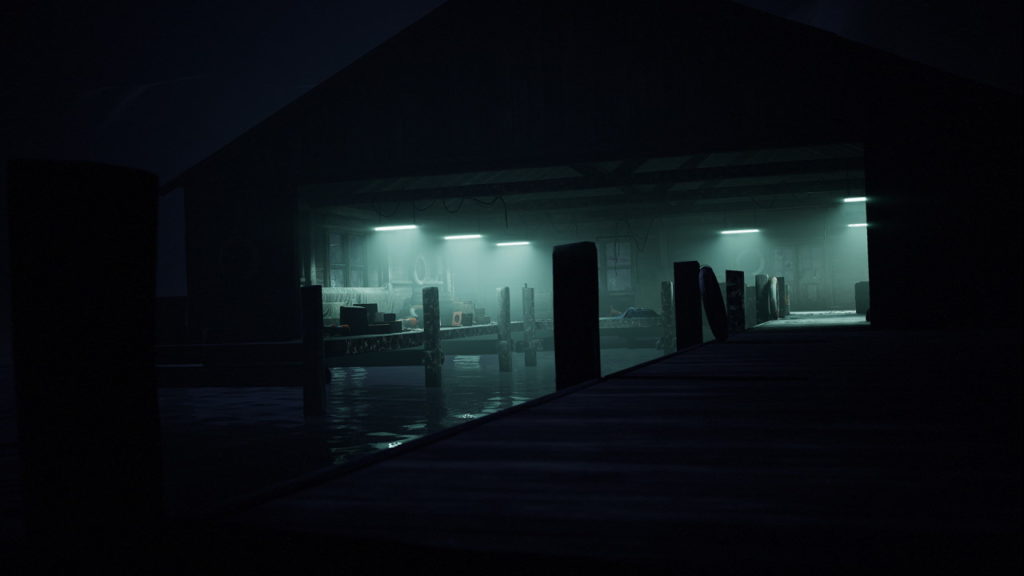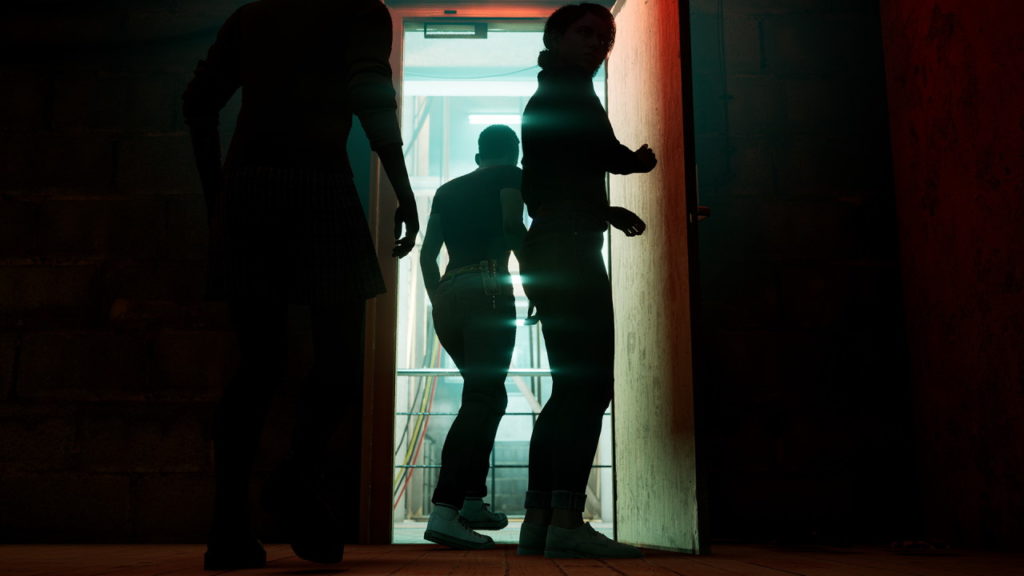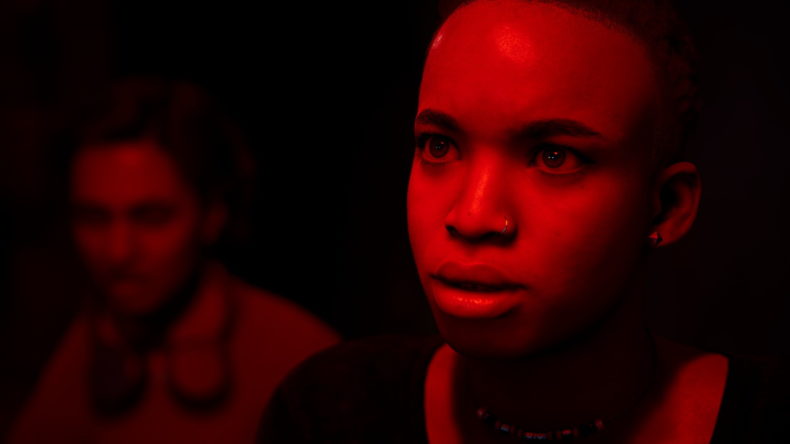Alongside playing a demo version of The Devil in Me, we also got a chance to interview Tom Heaton, the Creative Director of the game at Supermassive Games. Tom tells us what we can expect from the latest installment, and we discuss everything from the plot, to the new features, as well as the future of the series as a whole.
Read on below for the full The Devil in Me interview.
Interview with The Devil in Me Creative Director Tom Heaton
Plot and influence
Chris Hyde: Hi Tom, and thank you for taking the time to speak to me today. I guess the best place to start is if you could talk about what we can expect story-wise from The Devil in Me.
Tom Heaton: OK Sure. I’ll talk a bit about the inspiration for the story first. The Devil in Me is inspired by the American serial killer. H H Holmes, who was active in Chicago in the 1890s. It’s set in the present day, and it’s the story of a TV production company called Lonnit Entertainment, which is making a series about American serial killers. It’s called Architects of Murder, and they’ve got to the final episode of the series, which is about H H Holmes, and they need it to be really good because they need to secure a second series.
But unfortunately, a) they’ve run out of money because they are a really small outfit and b) they’ve chosen poorly cause H H Holmes is a very cold case if you’re making a documentary. It all happened 140 years ago, no one is alive to interview and the famous building he built – this hotel he murdered people in was very full of very elaborate traps and weird corridors and things like that – has been knocked down. They haven’t got anything.
And out of the blue, they get a phone call from someone called Granthem Du’Met, who tells them he has a hotel that he’s inherited, which is partially based on HH Holmes’s hotel, including the interiors which are replicas of some of the rooms. So this is gold dust for this TV documentary crew and they immediately agree.
To go, they agree to lots of privacy conditions. They hand over their phones, and they’re driven in a limousine with smoked-out windows to a mysterious lakeside location and taken across the lake to an island where this hotel, is kind of falling down and rotting.
Yes, and the hotel’s perfect. It’s brilliant. It’s just what they want for the series. So they settle in but straight away things start to go wrong. They feel like they’re being watched – they are being watched – and they realised that the hotel is a very accurate replica of Homes’ hotel indeed.

CH: You talked about obvious influences, like the murder Castle, but you also get a very “Saw” film vibe from this. Are there any other influences we can expect in the game?
TH: Yeah. So, Saw is a definite influence and we’ve steered away from the torture porn side of Saw, but what we have got are these really compelling, horrible dilemmas. The players are forced by someone that’s watching them and controlling them and is hidden. They’re forced to make these terrible decisions between people, so that is very, very Saw-influenced. The other big influences are The Shining because we got a hotel that’s malevolent, that’s creepy, that is, unstable in the way in the way it works. So that’s a huge influence and people will see little nods to The Shining, which is my favourite horror film by the way, if not one of my favorite films. They will see that all the way through the game and the other influence are kinds of fairly old-school slasher movies. I’m thinking especially about the Halloween series. That’s a big influence, the game goes to those sorts of places.
The Cast
CH: And in terms of the cast this time around, there always tends to be quite a diverse cast in The Dark Pictures games, you know, age, ethnicity, backgrounds etc. What considerations were made for the cast for The Devil in Me?
TH: So right from the start we wanted a story about working professionals, people that had jobs, people like you and me, and people like your audience, people trying to make ends meet, and do a good job. So they’re professional people, they’re working together.
And that you know they were small outfit in a small office. So there’s all the sort of normal internal rivalries. They’re living in each other’s pockets really. And so internal rivalries, friendships, and support groups are all there. And most of the cast is late 20s, or early 30s, no three of them are. And then we’ve got 2 slightly different characters. We got Charlie, the director, who’s British and he’s older and he’s the person that set up this company and we got Erin, who’s younger than the others. She’s the intern, new, she doesn’t really know anyone. She’s a little bit cowed by all these people who know a lot more than her, so yes, it is diverse, it’s diverse in lots of ways. And we get real texture from those differences between the characters, how they play off against each other, etc is really important.
New Gameplay
CH: There are a couple of what feel like big gameplay changes in The Devil in Me compared to previous games in the Anthology. One of them is the expanded movement actions that are in the game. How do you think they changed the way it feels to play this particular game versus the previous games in the series?
TH: So you are right there, they’re really big changes. But one thing that was important was we stayed true to the core of what a Dark Pictures game was, you know? It’s all about cinematic branching horror, and that is still very much the case. We’ve always had exploration, we’ve always allowed players to free roam across these scary and creepy environments that our art teams create and find things in the world and just try and help themselves survive the night.
But we decided to increase the player agency in those sections, so players have now got much more to do; they can jump, vault, climb, crouch, crawl, shimmy across ledges, balance across beams, squeeze through gaps, and it’s all about giving the player more control, more responsibility. It allows our level design teams to create interesting nonlinear levels and populate those levels with secret areas that the player has to work to find, where there are things that are useful to them. It allows us to set challenges about “How do you get across there?”, “How would you reach this bit of the level?” and you have to kind of engage with the level and work out how to do it. So yeah, we think it really works. It’s been fun developing those features and playing the new types of levels that we can create, but it fits really well into this into our existing structures as well.

CH: Yeah, 100%. I’ve played the preview slice of the game and you’re right. You’re still in keeping with the decision-making, but there is certainly in that kind of hour of gameplay a noticeable difference. My character is moving around and solving puzzles and that feels like a more prominent part of the gameplay as well as exploration, it’s part of the exploration.
TH: Yeah, so we got a couple of new features, and one of those is puzzles. Going back to the source material, HH Holmes loved to confuse and disorientate his victims with the walls that moved and the trap doors, and the rooms that were completely pitch black. So puzzles seemed like a very good fit and were a very early part of what we are putting together for The Devil in Me.
They’re not super, super difficult. It’s not a puzzle game. It’s a Dark Pictures game with some puzzles, so players will have to think a little bit. It’s things like looking for codes in the world, or there are some fuse boxes to fix. Sometimes it’s about pushing things around to find new paths through the world. Again, it’s about broadening the palette of what players will do in the game.
The other big new feature is tools and we’ve got a simple inventory that players can use. The tools they start with are tools that they would have naturally as part of their job. Or they can find tools in the world that are useful to them. And sometimes it’s about using them in explorations. Sometimes they are used in interactions, and sometimes they kind of tie into the branching of the game. Having a specific tool at a certain point can have a really big impact on the narrative.
The interface is very simple, it’s an inventory, but we don’t want players to do loads of inventory management, so it’s really stripped down and kept very simple. And again it’s just broadening the palette.
CH: Yeah. I was gonna ask about that. You did just touch on it, actually with the inventory. Is it going to be critical to have the right character having the right item at the right point? Does that get interwoven into the choices and narrative decisions?
TH: Yes, absolutely, as always in our games. If you don’t have that, or if you choose wrongly, the game will continue. Someone might get injured or worse, but the game will always continue. You will always get a really strong narrative, but absolutely the tools in places really tie strongly into the narrative and have a really big impact on the narrative, up to and including people dying.
Dying and game length
CH: Which is always what people focus on: the choices and how it can lead to how many characters survive the night and how many characters die. Is there anything you can kind of tell me about the number of permutations or choices or how many ways there are to die in this game?
TH: I can’t give exact numbers. There are lots of ways to die and we always have lots of ways to die. That’s one of the things that people are looking for in this sort of game. They’re playing a horror movie if you like. So they want to see some deaths and the deaths have to be over the top and usually pretty gory. And they have to mean something. They can’t just be people dying. You have to have got to know those people and feel for them and feel the loss. So there are a lot of deaths. I haven’t got a number, but there’s plenty and they are spectacular. I think it’s one of the great things about this setup, the serial killer and the hotel full of traps is there are some really, really horrible deaths and we’ve enjoyed making those.
CH: I think you have to enjoy that aspect of it, right? If you’re making a Dark Pictures game. Another thing I want to talk about was the runtime. I think it’s about 7, maybe 7 to 8 hours to play through, which is a little bit longer than some of the other games earlier in the series. Is it just that there is more story to tell here? Or is there something else at play that makes this a longer experience?
TH: I think there are a few things, we’re always learning on the Dark Pictures. We’re always looking at what we’ve made and looking at how people have responded to it, the press, but also the fans and how we feel about it ourselves. And one of the things we were looking at was a shift to a longer game time. It allows us to tell the story more fully. It allows us to spend more time with the characters and get to know them more and for them to undergo change and have those character arcs that people really value.
So yes, that was part of why the runtime will be over 7 hours. People play games in different ways. So some people, if they’re looking for every single secret read every single thing they find and they’ll spend a bit more than that. But it will be over 7 hours. And I think as well we’ve got all these new gameplay mechanics that need some space as well. Players need a bit of time to get to know that. So that’s another factor behind it.

Favourite Scene
CH: So with the bigger game, what’s your favourite scene or part of it that you’re happy to share?
TH: You know, I’ve been working on this so, long, for three years, so it’s very difficult. I have a lot of favourite bits and I must be careful not to spoil the game. But there’s a bit I think you would have played in the demo where they all kind of get together for dinner and they’re kind of working out that it’s a bit of a crisis. The guys, seem to be on their own, they don’t know where anyone is. Things haven’t really kicked off yet, but things are definitely going wrong and that’s a very central scene.
It can go in a number of very, very different directions, but also it’s really all about the relationships between these characters. That’s when they’re really tested. And one of the things we love to do in games is often about testing characters and the relationships between them under extreme pressure that can end horribly. So that is a fun scene because we really get a glimpse into all those working relationships. But there are loads of great scenes. I’m very pleased with how it turned out and I think people have their favorites when they play the whole thing, which then we could talk about without spoiling the game.
CH: Yeah, I will say the same for me. It is obviously difficult with the preview restrictions, you get the “Bearings” message come up and you think there’s definitely something in this that going to drive something else later. Definitely an interesting character scene there.
The future
CH: The Devil in Me is the Series 1 finale for the Dark Pictures Anthology. Is there anything special because it’s the finale? Is there anything we can expect because of that, ahead of Series 2?
TH: Well, there are a couple of things, but first of all, one of the reasons we’ve thrown all these new features at it is because it’s the finale. So we wanted to end with a bang. So there’s a whole bunch of new features that people will play and discover. And the other thing is we will see a bit of development of the Curator’s story as well. The Curator is on a long, slow arc that will continue well into Season 2, but they’ll be developments around that as well.
CH: I definitely got a vibe of frustration on his part, in the short part I played which I think was very interesting.
TH: Yeah, OK. Right, good. (Tom gives a knowing grin)
CH: It’s interesting how that’s developed over the games, I think I’d have to go back and play them in order to see it. But I definitely got that vibe.
CH: My last question actually is about the future. Those new mechanics that have been introduced, is it likely they could feature in future Dark Pictures games or are they just designed uniquely for The Devil in Me?
TH: No, they will use them going forward. It’s always the plan to keep building, keep adding, adding features to the formula really. So in general, yes there’ll be in future games as well. They might not all be. I think it’s about the needs of those particular stories. They might say, “Actually we don’t need this one for this story.” But yeah, you’ll see those features come back. I think they’re important to us. I think you’ll see other new features come in as well.
And it’s one of the great things about these games is it’s a very flexible formula. We’re always trying to do completely different subgenres of horror, which have their own requirements and their own beats. So there’s a little bit of pick and mix there in terms of features, but definitely, you can see those features in future games as well, yeah.
The Dark Pictures Anthology: The Devil in Me is out on November 18th for PC, PS4, PS5, Xbox One, and Xbox Series S|X.





